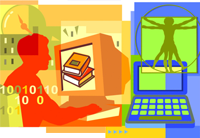
Update From Brett
Early Steps on the Academic Mission Path

IT is more than creating great tools...how can these tools enhance learning?
During the Annual Kickoff, I stated that one of our three primary strategies for FY12 is a focus on the academic mission of the university. There are already several examples of ways we are innovatively reaching out to our academic counterparts.
The SACS Accreditation committee has reaccredited Emory for the next ten years, giving us valuable access to the highest quality of students and ensuring that we maintain eligibility for student financial aid through the US Department of Education. Our accreditation signifies that Emory "has a mission appropriate to higher education, has resources, programs, and services sufficient to accomplish and sustain that mission, and maintains clearly specified educational objectives that are consistent with its mission and appropriate to the degrees it offers, and that indicate whether it is successful in achieving its stated objectives."
We have also recently begun a committee for instructional governance. Those committee members, made up of leaders from across campus, are meeting to examine our teaching methodologies and discuss new ways to apply technological advances and services to everyday learning techniques. Stay tuned for more information on this effort.
A strategy for next generation LearnLink is trending toward adoption of "GoingOn," a modern, data-oriented tool that allows analytics (knowledge clouds regarding how students are using course material and classroom discussion) to create a more advanced IT function for a well-rehearsed, student-oriented collaboration experience in LearnLink. Alan Cattier (Academic Technology Services) met recently with the President and CEO of GoingOn and was impressed by their business model for manageable collaboration and use of a social platform. "GoingOn" offers several ways UTS can enhance the academic mission.
Members in our organization are also looking at mining Blackboard (Bb) data, in collaboration with the School of Medicine (SOM), to do comparative discussion about how successful students use Bb. We believe that there are measurable standards of use that predict student success in the coursework. The next step in this effort might be to find an educational studies doctoral student who would run an experiment to measure the effectiveness of the Bb OPUS project and focus on enduser descriptions of typical use.
This year we are planning to perform customer relationship management (CRM) with Enrollment Services to improve admissions. This plan is still in discussion but will probably heavily utilize PeopleSoft services as well.
There is a library retreat coming up and an expected outcome is a roadmap for co-creating a service with the library to help graduate students and researchers with their data management plans (curating, archiving, and sharing data during and after research projects). Currently they only use ad hoc methods but we are engaging the storage team to develop shared practices around revising the design and use of our ticketing system to help the library keep track of service requests for a non IT-based offering.
These projects offer some exciting initial steps in applying more focus to our academic mission at Emory. These and many others should inspire collaboration and innovation throughout our division and I look forward to hearing about our progress as the fiscal year continues.
- Brett Coryell, Deputy CIO, UTS